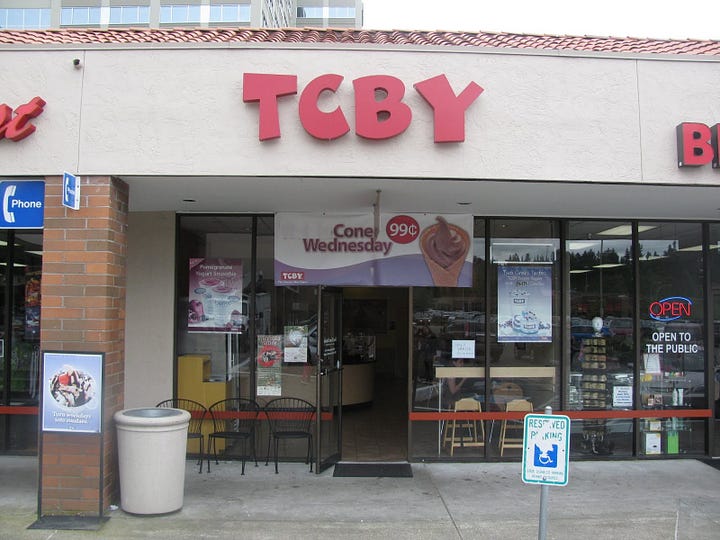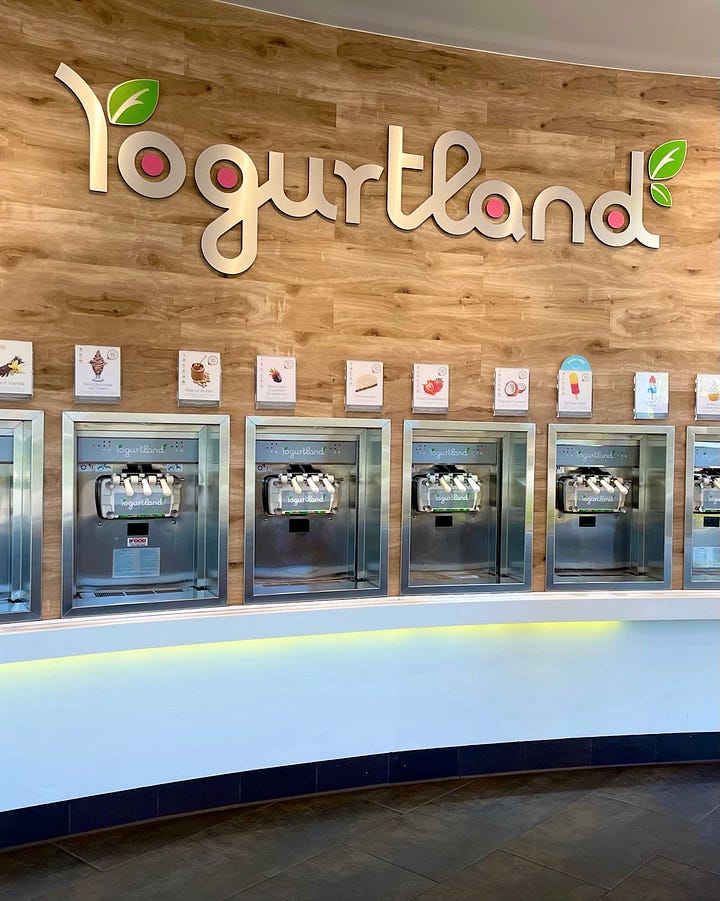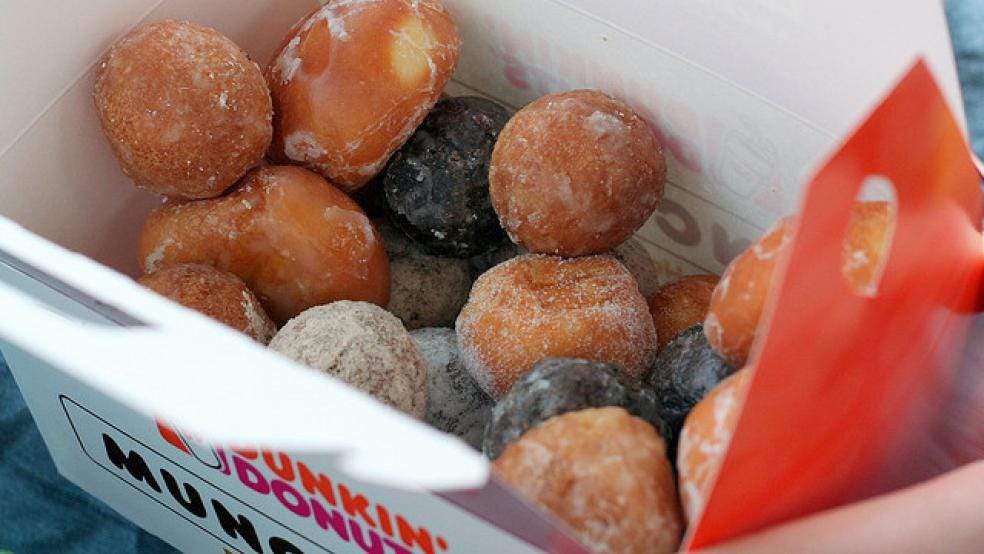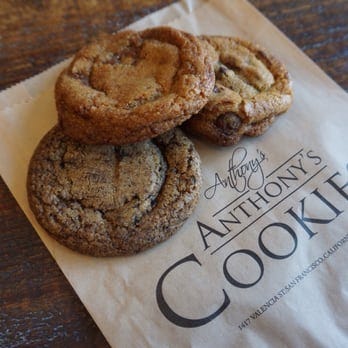little treat culture
the tragic fall of frozen yogurt and the rise of the internet's "little treats"
I am a proud member of a sweet-tooth family. (We are also a fashion show family, but that’s another story for another post). Most nights, around 8 PM, one or both of my parents would suggest a little something sweet to eat. I remember after-school visits to TCBY for fro-yo, weekend trips to Great Harvest for cinnamon rolls, or weeknight Toll House cookie dough in the oven. This period of time, when I was at home with my family, also coincided with the Great Dessert Craze of the early 2010s. It seems that in those days, treats were a fixture of our lives, and not just in my family, but in the culture.
The 2010s saw a series of dessert fads—they were strong, they came on fast, and they left us almost as quickly. I’m sure the “why” is a combination of things—the difficulties of maintaining scalable business models, the nature of trends. Maybe even the rise of “wellness” culture (pressed juices, etc.) is to blame. As a treat connoisseur, I want to take us back to this time, consider what these little treats have come to mean or provide, the rise and fall of dessert, as well as the evolution of what the internet would call “little treat culture.”
Prelude: OG Munch
Of course we’ve had Krispy Kreme and Dunkin’ for a while. Those guys, thankfully, don’t seem to be going anywhere. When I was growing up, my mom worked in a church, and we never missed Sunday Mass. Every week, my brother and I looked forward to stuffing our faces with Munchkins as soon as the priest hit the last pew on the walk out. Donuts will always take me back to that time, and the simplicity of the dessert reflects the simplicity of that time I spent doing nothing with my brother, waiting for my mom to get off work.
Act One: Cupcakes for the Masses
The cupcake trend allegedly began around 2009, inspired by none other than *the* Carrie Bradshaw, the original influencer, when the girls went to Magnolia Bakery in an episode of Sex and the City. From then, Crumbs Bakery opened, and soon dominated the market, Cupcake Wars aired on TLC, Sprinkles Cupcakes took over L.A., and popular local chains—Kara’s Cupcakes in SF, Cupcake Royale in Seattle and Georgetown Cupcake in Washington, D.C.—popped up. Some, like Sprinkles, are still around.
Every time I went to my aunt’s house for dinner in high school (2009-2013), we’d have Kara’s Cupcakes for dessert and I felt so decadent. I get the appeal of the humble cupcake. You want the feeling of a piece of cake, but not the commitment. You can go with a group and each enjoy your preferred flavor—my dad loves carrot cake, I prefer the classic yellow cake and chocolate icing. I will say, cupcakes didn’t comfort me the way that other treats on this list have, but their prevalence in the culture at the time no doubt carries strong connotations. Maybe in 2009-2012, in the wake of the financial crisis, we needed a quick but luxurious indulgence even more. In fashion trends during this period, we certainly saw a spike in excess (epitomized in the rise of the Kardashians, for instance) as a result of the recession.


Act Two: Fro-Yo Shops on Every Corner
Pinkberry, Red Mango, 16 Handles, The Big Chill, Yogurtland. Frozen yogurt has cycled through in popularity, like any good trend, and of course we had TCBY in the early 2000s when frozen yogurt was presented as a “healthy” alternative to ice cream. But, my god. Nothing compares to the Frozen Yogurt Wars of 2013-2016 (roughly).
In college, we had a Yogurtland—Yogurtlandia, we called her. But I think she closed within my first or second year. My friends and I would walk the mile from campus into our sad little college town, grab our cups and crushed toppings and always laughing on the walk back together, feeling sticky and happy. Frozen yogurt shops gave you a sense of control: you often could pull the yogurt lever yourself, choose your toppings, and customize your treat, all within the span of a couple minutes.


Honorable Mention: The Humble Cookie
I think we can all agree that the most epic birthday parties had cookie cakes from Mrs. Field’s. Those were the kids with the moms that were a little edgy or quirky. Mrs. Fields really held it down, and in my opinion, the cookie should have had the cultural cache of the cupcake, on comfort factor alone. I think cookies never quite took off because we needed something more decadent at the time.
There are Crumble and Insomnia cookies, and in the Bay there’s Anthony’s which deserves the Pulitzer prize for cookies, but I think in general there should be more cookie stores. The chocolate chip cookie, to me, is the ultimate little treat.
Home-Treats
I often think, too, about how these treats are associated with regions, places, and times in our lives. TCBY and Dunkin’ Donuts will always make me think about childhood, which I spent between Texas and the East Coast. Yogurtland will always make me think about college. Part of what’s sad when these fads go away (even though this is all a romanticization of capitalism, in a way) is that I can’t use food to revisit that time and gain a sense of continuity, to feel my past alive with me now. And even if they were still around, they might be in places I no longer live (like the blueberry muffin at Russell’s Bakery in Austin, TX), or foods I can no longer eat, now that I have allergies that don’t let me partake in these food-based rituals.
I do feel largely melancholy that I can’t eat a lot of Mexican food anymore—enchiladas, pan dulce—because I am lactose-and gluten-intolerant. This has led me in the search of the perfect gluten and dairy free concha recipe. (I do think I’ve found a really good substitute, and I can share it in a separate post soon, if you’re curious). Part of the little treat comfort comes from the serotonin we get when we eat something yummy, but it’s also one of the few ways we can go back in time. Part of what we talk about when we say that we’ve been triggered is that our body believes we are back in a time when we were not safe, and we believe the same thing is happening again. I think treats give us the opposite experience, and it’s one of the ways that a physical, transformative object—something we take in and choose to alter our body—can take us back in time and convince us, for a moment, that all the good we associate with it is happening to us again. If in the past I’ve shared on this Substack that tattoos are a visceral way for us to alter our bodies and project a new kind of future, I would add treats as a tool of the visceral, where we tunnel backwards in time to project safety in the present.
The little treat is often villainized for being “unhealthy,” and not carrying nutritious value. But this notion cuts us off from our bodies, and from recognizing that nutrition and what we feed ourselves is about more than the energy that can be converted into productivity. Our bodies are not something to “hack,” they are something to nurture.
Little treats remind me that that which is considered “excess” in food— too sweet, too sugary, unnecessary — isn’t dissimilar to other “excesses” in our society. To be “too sexual,” “too loud,” “too angry,” or “too emotional,” all carry with them the notion that normativity will save us. But in my experience, embodying so-called surplus feelings have been the moments that have saved me. It is okay to seek relief.
Discourse
Generally, it’s interesting to me that the rise of the now meme-ified term “little treat” (roughly 2017, according to this intrepid journalist) has come when we’re, it seems to me, in the down-swing of the treat economy. Of course there are still bakeries, Starbucks, boba shops, ice cream shops, and other treat vendors. But since 2017, the culture of deserving a “little treat” has only gained momentum, while the treat conglomerates are few and far between.
Recently I’ve been listening to the Vox podcast series on capitalism, and the host Noel King gave an excellent interview with Brittany Luse on It’s Been a Minute, where King presented her hypothesis that as a culture we are discussing capitalism’s systemic violence to an extent that we have not before. Or at least, more people than ever before understand that capitalism is a system that structures our daily lives, and usually makes living harder. I think the up-swing in “little treat” culture has a lot to do with this awareness and growing disillusionment with capitalism. The logic goes: capitalism structures my life in a way that A) feels out of my control, and B) depletes my spirit, so C) I deserve a little treat.
It’s almost poetic that as nationally legible treat companies declined (AKA Big Treat), we as a culture adopted a self-aware, performative treat practice, but Big Treat can’t benefit from it in the same way. I wonder if what we’ve witnessed is the lessening of dessert culture as a symbol of luxury, and the rise of treats as a critical practice. One of the things I love about the notion “you deserve a little treat,” is that it builds the “common sense” idea that we are already worthy of rest and healing, regardless of productivity. Understanding little treats as a practice also brings us into the present moment, where we grow into deeper awareness with our consumption. I like to think that it enlivens us to the rhythms of our bodies, that we can allow ourselves to feel and consume, and build collective understanding around self-compassion. So all that said, go forth, and get yourself a tiny, perfect, treat.






